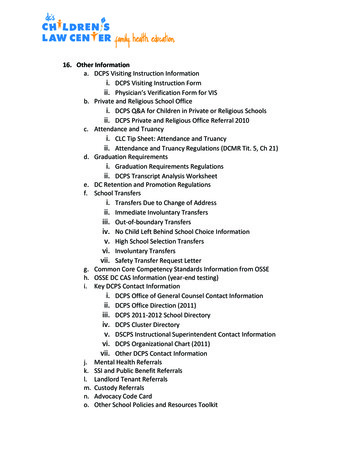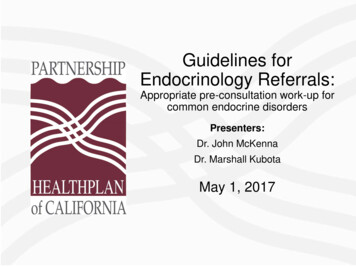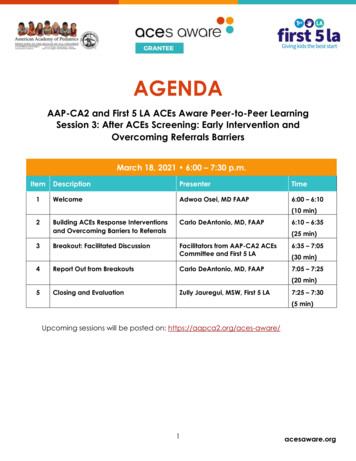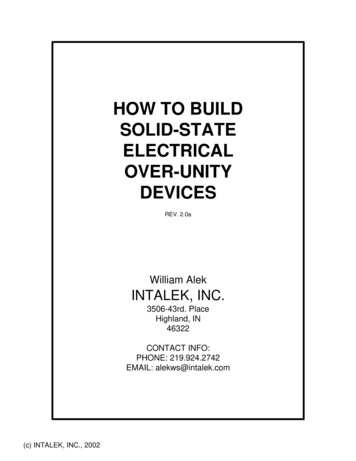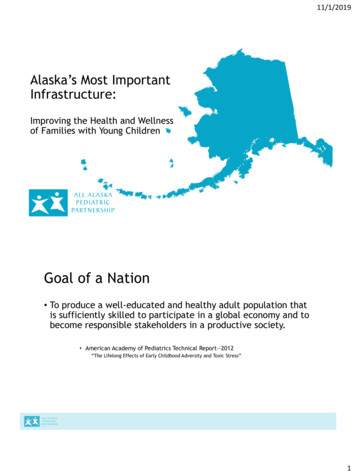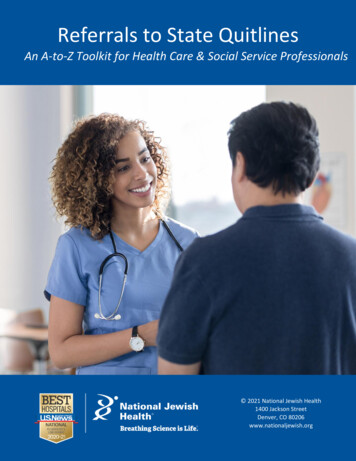
Transcription
Referrals to State QuitlinesAn A-to-Z Toolkit for Health Care & Social Service Professionals 2021 National Jewish Health1400 Jackson StreetDenver, CO 80206www.nationaljewish.org
ContentsIntroduction . 2I. Treating Commercial Tobacco Use in a Health Care Setting . 3Why treat commercial tobacco use. 3How to treat commercial tobacco use . 5II. How State Quitlines Help Clinics Provide Tobacco Treatment . 7What is a state quitline? . 7Why refer to the state quitline . 7What a patient can expect from the state quitline . 8III. How Referral to a State Quitline Works . 9Connecting through referral . 10IV. How to Implement a Referral System . 13Step 1: Assess your clinic’s readiness . 13Step 2: Create a Quitline Referral Team . 15Step 3: Identify key actions and create a plan. 16Tips to support quitline referral workflows. 17V. Tips and Suggestions for Optimizing Referrals. 21Use progress reports . 21Promotion of cessation and the state quitline to patients. 21Education and training of providers and clinic staff . 21Appendix A: Key Terms. 22Appendix B: Clinic Readiness Checklists . 24Appendix C: Quitline Referrals Help Clinics Meet Quality and Performance Measures . 30Appendix D: Project Tracking Templates . 31Appendix E: Example Workflow for Fax or Web Referral . 331
IntroductionThe aim of this toolkit is to assist you – a health care or social service professional – in your role as an advocatefor commercial tobacco1 treatment. Together, we are delivering an essential strategy to reduce commercialtobacco use: making quit help easy to access.2The toolkit seeks to support your role in this strategy by: Guiding you through quitline referrals that connect patients or clients who use commercial tobaccoproducts with state quitlines. Serving as a reference guide to set up a quitline referral system. Identifying methods to optimize quitline referrals, ensuring all patients who use commercial tobaccoproducts receive treatment and support.This toolkit follows the key components ofquitline referrals, allowing you to read thedocument as a whole, from beginning to end,or easily navigate to key sections forinformation and assistance to meet yourneeds.Using the preceding Contents page, hover overeach section title and Ctrl click to navigate tothe corresponding section. We have alsoenabled text search. And for reference, a list ofkey terms can be found in Appendix A: KeyTerms.A note to social service professionals: thistoolkit uses the terms clinic, patient, and healthcare organization frequently. We believe thecontent is easily adaptable to social servicesettings, helping clients who use commercialtobacco products receive the help and supportthey need to quit for good.1National Jewish Health recognizes and affirms the sacred purpose of tobacco for many American Indian tribes. We use the term commercialtobacco – tobacco that is commercially manufactured and sold for consumption and not the sacred tobacco used for cultural, spiritual, andceremonial purposes by American Indians and other groups.2 Centers for Disease Control and Prevention, Adult Tobacco Use Infographic. ex.htm#down.Accessed June 25, 2021.2
I. Treating Commercial Tobacco Use in a Health Care SettingWhy treat commercial tobacco useResearch definitively shows that smoking harms nearly every organ in the body and remains the leading cause ofpreventable disease and death.3 The following figure from the 2014 Surgeon General’s Report identifiesnumerous negative health impacts causally linked to smoking.Figure 1.1AThe health consequences causally linked to smokingSource: USDHHS 2004, 2006, 2012.Note: Each condition presented in bold text and followed by an asterisk (*) is a new disease that has been causallylinked to smoking in this report.3U.S. Department of Health and Human Services. The Health Consequences of Smoking: 50 Years of Progress. A Report of the Surgeon General.Atlanta, GA: U.S. Department of Health and Human Services, Centers for Disease Control and Prevention, National Center for Chronic DiseasePrevention and Health Promotion, Office on Smoking and Health, 2014. Printed with corrections, January 2014.3
And with these cancers and chronic diseases follows more than 480,000 preventable deaths each year. Smokingcommercial tobacco causes more deaths than the combined impact of HIV, illegal drug use, alcohol use, motorvehicle injuries, and firearm related incidents.4Despite declining smoking rates among adults, the risk of dying from smoking has increased over the past 50years as understanding of smoking-related deaths improved – causing 90% of all lung cancer deaths and 80% ofall deaths from COPD.3 Smoking increases the risk for illness throughout the body, in particular for diseases thataffect our heart, brain, and lungs. 3Coronary Heart Disease:2 to 4 times increased riskStroke:2 to 4 times increased riskLung Cancer:25 times increased riskImages sourced from Bing online search in Creative Commons4The Centers for Disease Control and Prevention. Office on Smoking and Health. Health Effects of Smoking. Available at:https://www.cdc.gov/tobacco/data statistics/fact sheets/health effects/effects cig smoking/. Accessed on May 21, 2021.4
Beyond the chronic diseases it causes, commercial tobacco use is a chronic condition and quitting is hard.Quitting is made easier with consistent treatment from every provider delivered at every encounter. Withover 34 million American adults who currently smoke, there are many people who need and want help withquitting. 5How to treat commercial tobacco useResearch clearly demonstrates that health care professionals can make a difference by asking about commercialtobacco use and connecting patients with treatment.6 In fact, a brief intervention of less than 3 minutesdelivered by a provider can increase the likelihood of a patient quitting by 1.4 times compared to nointervention at all.7Did you know? A brief intervention of less than 3 minutes delivered by a provider increasesthe likelihood of a patient quitting commercial tobacco products.Ask, Advise, Connect – an adapted version of the well-known Ask, Advise, Refer (AAR)8 that requires sending areferral – is an evidence-based protocol that health professionals use to connect patients to tobacco treatmentthrough referral to the state quitline. Ask, Advise, Connect takes less than 3 minutes and the steps are easy toremember.5https://www.cdc.gov/tobacco/data statistics/fact sheets/adult data/cig smoking/index.htmTobacco Use and Dependence Guideline Panel. Treating Tobacco Use and Dependence: 2008 Update. Rockville (MD): US Department of Healthand Human Services; 2008 May. Available from: https://www.ncbi.nlm.nih.gov/books/NBK63952/.7 Clinical Practice Guideline Treating Tobacco Use and Dependence 2008 Update Panel, Liaisons, and Staff. A clinical practice guideline for treatingtobacco use and dependence: 2008 update. A U.S. Public Health Service report. Am J Prev Med. 2008 Aug;35(2):158-76. doi:10.1016/j.amepre.2008.04.009. PMID: 18617085; PMCID: PMC4465757.8 Vidrine JI, Shete S, Cao Y, Greisinger A, Harmonson P, Sharp B, Miles L, Zbikowski SM, Wetter DW. Ask-Advise-Connect: a new approach tosmoking treatment delivery in health care settings. JAMA Intern Med. 2013 Mar 25;173(6):458-64. doi: 10.1001/jamainternmed.2013.3751.65
Most health care settings already routinely ask about commercial tobacco use with their patients, especiallythose with an electronic medical record. Many providers also routinely advise people to quit smoking, with 66%of people who smoke reporting they received advice from a provider. However, fewer than 10% reported theyreceived counseling to quit, only 33% used a cessation medication, and just 6% used both supports.9 Using bothcounseling and medications can more than double the chances of quitting for good.7The resources in this document provide the information and tools you need to connect patients who usecommercial tobacco with treatment through a brief intervention and referral to the state quitline.Commercial tobacco treatment training resourcesLooking for resources to help train providers and other members of your team on how totreat commercial tobacco use and dependence?Below we have listed several key resources – all of which are free – developed by national experts in the field ofcommercial tobacco dependence and treatment. Quitline Program Website – To learn more about brief interventions and the Quitline, visit:https://quitpartnermn.com and click on “Professionals”. QuitLogix Education Online - Up to 2 hours of accredited learning modules in 15-minute increments forfree provided by National Jewish Health with support from the Quitline. To view the learning modules, visit:https://quitlogixeducation.org/minnesota Rx for Change - A free commercial tobacco treatment training program for health professionals developedby national experts from The Smoking Cessation Leadership Center, The Robert Wood Johnson Foundation,and The Truth Initiative:https://rxforchange.ucsf.edu/ Training for Clinicians - This series of training videos was developed by national experts from the Center forTobacco Research and Intervention at the University of Henley SJ, Asman K, Momin B, et al. Smoking cessation behaviors among older U.S. adults. Prev Med Rep. 2019;16:100978. Published 2019 Aug17. doi:10.1016/j.pmedr.2019.100978.6
II. How State Quitlines Help Clinics Provide Tobacco TreatmentTelephone quitlines have been assisting clinics with treating tobacco use for nearly 30 years. Implementingreferrals to the state quitline is an efficient way to ensure your patients who use commercial tobacco haveaccess to free evidence-based treatment services.What is a state quitline?A state quitline is a commercial tobacco treatment program available in every state, paid for by the state’shealth department, available at no cost to state residents. A state quitline is highly accessible and evidencebased treatment and support program that is clinically-proven to achieve high quit rates.When a person enrolls in a quitline program, they have access to: Coaching over the phone from trained tobacco treatment specialists with additional support availablevia email, text, or online chat. Quit medications such as nicotine replacement therapy (NRT) patches, gum, or lozenges (eligibilityrequired). Some quitlines offer both prescription and over-the-counter quit medications. Quit planning and educational self-help materials to map out their path to quitting commercialtobacco. Membership in an online community with others who are working to quit commercial tobacco.Participants can select which parts of the quitline program work for them to create customized support.However, NRT and coaching are always encouraged because the clinical practice guidelines shows thatcombining coaching and NRT gives people who use commercial tobacco the best chance of quitting.Why refer to the state quitlineMaking a referral to the state quitline is an easy and effective way to help people quit. Compared to developingyour own treatment program and treating one patient at a time, quitline referrals enable your clinic toconsistently, efficiently, and effectively offer treatment to all patients who use commercial tobacco. Even if youalready have staff who provide treatment, the state quitline can extend the hours and availability of your clinicto reach more patients. Quitline referrals further benefit your clinic in multiple ways:7
What a patient can expect from the state quitlineYour patients may feel uncertain about a referral to the state quitline because they do not know what thatmeans or what will happen. When you refer a patient to the state quitline for commercial tobacco treatment,they can expect a simple, streamlined process to access evidence-based support:8
III. How Referral to a State Quitline WorksProtocols like Ask, Advise, Connect make referral of patients who use commercial tobacco products to statequitlines a regular and consistent part of your clinic workflow. The figure below provides a sample flow for theprocess from clinic to quitline referral that can be completed in less than 3 minutes across the entire care team.9
Connecting through referralActively connecting a patient to the state quitline requires sending a referral. There are three referral modesyour clinic can choose to implement – fax, web, or eReferral. The referral mode you implement in your clinic isbased on the clinic’s staffing capacity and technology infrastructure. The workflow for providers and care teammembers to generate and send the referral will be unique to each clinic.Below we have outlined a general workflow for each referral mode, highlighting steps other clinics have foundessential for successful implementation. Follow these steps to help you design a referral workflow that will meetyour clinic’s needs.Referral Modes and General WorkflowFAXWEBEREFERRALProvider or care team membercompletes a paper form with thepatient, capturing: Patient contact information. Health insurance information. Patient consent for referral.Provider or care team membercompletes the online referralform via the state quitlinewebsite.Provider or care team membercompletes the referral in theclinic's EHR using the establishedreferral template.Provider or care team membercompletes the online form withthe patient, capturing: Patient contact information. Health insurance information. Patient consent for referralusing a required checkbox.Referral is automatically sent tothe quitline via secure, two-waycommunication between theclinic's EHR and the quitline'sHIPAA-compliant system.Fax forms that are handwrittenshould be reviewed to ensure theform is complete and thehandwriting is legible.Fax forms are collected by a careteam member and manuallyfaxed to the state quitline.Care team members check examrooms daily to replenish stock ofpaper fax forms in each examroom.Providers receive progress notesvia fax or secure email. Notes arereviewed and scanned into thepatient's medical record.Web forms are securely sentonline by clicking on submitimmediately after completing theform with the patient.Clinics and providers receiveprogress updates directlyuploaded to the EHR from thequitline.Providers receive progress notesvia fax or secure email. Notes arereviewed and scanned into thepatient's medical record.10
What happens when the quitline receives a referral?After receiving a referral, the state quitline’s staff begins the process of reaching out to engage the patient. Thevisual below provides you with the overall flow of a referral once the state quitline receives it and howinformation from the quitline is sent back to the clinic.REFERRAL RECEIVEDReferrals received by the quitline are uploaded to asecure HIPAA-compliant case management system. Web forms and eReferrals are automatically loaded. Fax forms are manually processed and individuallyscanned.Progress note is sent indicating the referral was receivedor invalid. Common issues for invalid referrals include: Critical information was missing, i.e. phone number. Consent checkbox unchecked / no consent provided. Illegible handwriting.REFERRAL VALIDATEDReferrals are verified to determine if the patient: Is eligible for state quitline services based on thepatient's zip code. If not, progress note is sent indicating the referral wasclosed as ineligible.Referrals are verified to determine if the patient: Has an open referral or is already enrolled with thestate quitline. If the patient has already been referred or has an openfile, the new referral is closed as already participating.PATIENT OUTREACH INITIATEDThe qutiline makes up to 5 calls to reach each patientover 2 weeks. Outreach calls begin within 1 business dayof a referral being received and processed. If the patient doesn't answer any call, and gavepermission, the quitline will leave a voicemail. The quitline sends a text message,if the patientconsented to receive text messages. If the quitline was not able to reach the patient after alloutreach attempted, progress note is sent indicating thereferral was closed as unreachable.PATIENT CONTACTEDThe quitline staff provides the patient with informationon the programs for which the patient is eligible. If the patient agrees to register for the program only,progress note is sent indicating the referral was closed asintake only. If the patient agreesto register and completes acoaching call, progress note is sent that the referral wasclosed as enrolled. If the patients declines enrollment, progress note is sentthat the referral was closed as declined.11
Do clinics receive updates on referrals made to the state quitline?Clinics that are also HIPAA-covered entities receive progress note updates on all patients referred to the statequitline. The progress note is sent by fax or secure email with the following information: If the quitline was able to reach the patient.If the patient enrolled in quitline services.How many counseling calls the patient completed.How much cessation medication the patient received.How progress notes are provided back to your clinic will depend on which quitline referral mode the clinicimplements. Fax referrals and web referrals will receive progress notes sent by fax or as aPDF report send in secure email. These progress notes are manually reviewed and placed into the patient’smedical record. eReferral progress notes are sent via Direct Messaging back to the EHR. These progress notes can be set to automatically upload to the clinic EHRor may be sent to the providers inbox. Once loaded into the patient’schart, clinics can run reporting as needed and if required. See “eReferral Toolkit” for more detailed information on implementingeReferral and how to automate upload of progress notes. This toolkit islinked on the state quitline website following the links for providerreferrals.To download thePDF report from asecure email, useAdobe AcrobatReader version7.0 or higher.Then check theattachments onthe PDF to locatethe progressnote.How do clinics maintain or optimize a quitline referral system?An important part of implementing quitline referrals into the clinic workflow is setting up a sustainable processfor the long term. When clinics first send referrals to the quitline, it is common for clinics to send a high numberof referrals and then over time the number of referrals decreases as priorities shift.Clinics that maintain referrals have treatment champions or advocates who also focus on optimizing the referralworkflow process and ensure consistency over time. For example, quitline referral maintenance can be part ofthe clinic’s overall quality improvement or quality assurance plan and can draw on existing clinical qualitymeasures for treating commercial tobacco use to assess performance. Referral rates can be measured weekly,monthly, or quarterly, depending on the volume of patients in your clinic or health system.Including quitline referral as a clinical quality measure for commercial tobacco treatment can provide an earlysignal if there is a need for focused quality improvement efforts. For example, the quality improvement planmight include: Ensuring all new hires are trained on tobacco treatment protocols and referral workflows.Regularly retraining existing staff on tobacco treatment clinical workflows and protocols.Working with clinic IT team or EHR vendor to update systems.Working with clinic coding and billing teams on reimbursement for counseling.12
Additional tips for optimizing quitline referrals are provided later in this document (see V. Tips and Suggestionsfor Optimizing Referrals) and specific information on quality measures and reporting are outlined in Appendix C.IV. How to Implement a Referral SystemImplementing a quitline referral system requires support from team members internal and external to yourclinic or organization. In this section, we outline key steps to help guide you through the implementationprocess.Step 1: Assess your clinic’s readinessThe first step is to understand how ready your clinic is to implement quitline referrals and the supportingprotocols or workflows. We have developed a series of checklists to help you assess the readiness of your clinicin three key areas: Clinic administration. Equipping clinic care teams. Incorporating brief interventions for commercial tobacco treatment.Is your clinic’s administration ready?The checklist below focuses on key aspects of clinic administrative policies that are needed to support andmaintain quitline referrals. A “no” response to any question on the checklist becomes a key task to be addressedby the Quitline Referral Team as part of Step 2.Checklist on Clinic AdministrationAssessment QuestionDoes your clinic have a champion for commercial tobacco treatment within clinicadministration?ResponseYesNoDoes your clinic have a champion for commercial tobacco treatment within clinicalstaff?YesNoDoes your clinic have a policy that prioritizes commercial tobacco treatment?YesNoDoes your clinic have a policy to train and retrain staff on commercial tobaccotreatment protocols and workflows such as “Ask, Advise, Connect”?YesNoIs your clinical team ready?The checklist below focuses on key aspects of equipping and training clinic care team members to ensureworkflows and protocols for quitline referrals are consistently followed and maintained over time. A “no”response to any question on the checklist becomes a key task to be addressed by the Quitline Referral Team aspart of Step 2.13
Checklist on Equipping Clinic Care TeamsAssessment QuestionDoes your clinic conduct on-boarding training for new employees and annualtrainings for existing employees on commercial tobacco treatment protocols andworkflows such as “Ask, Advise, Connect”?ResponseYesNoDoes your clinic have a procedure to ensure billing for commercial tobaccotreatment?YesNoDoes your clinic have commercial tobacco treatment performance measures andquality goals for the clinic?YesNoDoes your clinic have commercial tobacco treatment performance measures andquality goals for providers or clinical care teams?YesNoAre the clinical protocols and workflows ready to incorporate a brief intervention?The checklist below focuses on key aspects of developing and implementing protocols and workflows forquitline referrals. A “no” response to any question on the checklist becomes a key task to be addressed by theQuitline Referral Team as part of Step 2.Checklist on Brief Intervention for Commercial Tobacco Treatment and Quitline Referrals(i.e., Ask, Advise, Connect)Assessment QuestionResponseHas your clinic adopted a brief intervention for commercial tobacco use,Yeslike “Ask, Advise, Connect”?NoDoes your clinic have a workflow that supports the brief intervention forcommercial tobacco?YesNoDoes your clinic have commercial tobacco use status prompts in the patientrecord system (i.e., EHR, or paper medical charts)?YesNoDoes your clinic have decision support for commercial tobacco usescreening in the patient record system (i.e., EHR, or paper medical charts)?YesNoDoes your clinic have standard order sets for counseling and medicationsused to treat commercial tobacco use?YesNoDoes your clinic have tools to guide providers and clinical care teams inselecting medication to treat commercial tobacco use?YesNoDoes your clinic have tools to assist providers and clinical care teams witheducating patients on medications used to treat commercial tobacco use?YesNo14
Does your clinic have a decisional support tool to guide providers andclinical care teams with helping patients plan their quit?YesNoDoes your clinic have a protocol and workflow for providers or clinical careteams to follow-up with patients who are quitting?YesNoAppendix B provides more detailed versions of these checklists that highlight possible follow-up questions oractions for your Quitline Referral Team.The checklist in Appendix B also connects you with key resources from the Centers for Disease Control andPrevention (CDC) Million Hearts Tobacco Cessation Change Package – a toolkit that provides additionalresources for implementation and maintenance of brief interventions for commercial tobacco use and quitlinereferrals, as well as broader health systems change efforts, across a variety of health care settings.Step 2: Create a Quitline Referral TeamTo ensure quitline referrals function when implemented and their function is maintained, form a team with keyclinic and support staff. You may also look to include someone who can represent the quitline, such as a state orlocal tobacco control grantee responsible for coordinating resources on the local level. Each team member willhave responsibilities to support implementation and maintenance of quitline referrals. Who you ask to helpsupport implementation of quitline referrals will depend on which referral mode (fax, web, eReferral) your clinicchooses to adopt and your clinic’s needs and existing resources.If your clinic is implementing eReferral, you will need staff from the state or local healthdepartment to provide additional assistance, resources and possibly funding to helpsupport implementation. eReferrals also require a testing phase directly with the quitlineand a representative can guide you through the process.Team MemberHealth System Change Advocate(you, or another member of thehealthcare team)Your Quitline Referral TeamHow does this team member supportimplementation of quitline referrals?Leads the implementation team.Implementation (I);Maintenance (M)I, MSets up team meetings and follows-up onkey action items in between meetings.Medical ProviderIdentifies training and workflow needs forclinicians. Completes Advise step in briefintervention. Writes prescriptions for quitmedications.I, MClinical Support Staff, MedicalAssistants, NursesIdentifies training and workflow needs forclinical care team. Completes the Ask andI, M15
Team MemberYour Quitline Referral TeamHow does this team member supportimplementation of quitline referrals?sends the referral to Connect with thequitline.Implementation (I);Maintenance (M)Quality Improvementmanager/staff membersIdentifies reporting to monitor clinicalquality measures to maintain and optimizereferrals.I, M as neededClinic Administrator,Management TeamPrioritizes the work and sets qualityimprovement goals.I, M as neededPharmacy Staff (if onsitepharmacy)Identifies pharmacist role in clinicalworkflows to fill prescriptions for quitmedications.I, M as neededInformation Technology(IT)/Electronic Health Record(EHR) StaffIdentifies EHR and IT capacity for electronicreferrals.I for electronic referrals, Mas neededState Quitline, State or LocalHealth Department or GranteeProvides Quitline information. Participatesin testing of referrals and troubleshooting.Connects the clinic to health improvementprograms and efforts in the state to addresscommercial tobacco use and treatment.I as needed, M as neededStep 3: Identify key actions and create a planOnce your Quitline Referral Team is formed, the next step is identifying the key actions or items needed for yourclinic to implement quitline referrals. Using the identified key actions and items, the Quitline Referral Team willcreate a plan tailored to the needs of your clinic. The advocate role within the Quitline Referral Team will takethe lead on tracking and following up on action items to ensure all the steps for the plan are completed for asuccessful implementation. Identify key action items – Implementation of quitline referrals key action items include: Clinical protocols, workflows (see Appendix E for an example workflow). Review training modules on Ask, Advise, Connect. Identify key roles for each step of Ask, Advise, Connect. Discuss IT/technology options for sending referrals and receiving progress notes. Test and refine referral workflows. Monitor number of quitline referrals and feedback reports. Set a timeline – Work with your team to set an ag
tobacco use: making quit help easy to access.2 . Research definitively shows that smoking harms nearly every organ in the body and remains the leading cause of . Making a referral to the state quitline is an easy and effective way to

